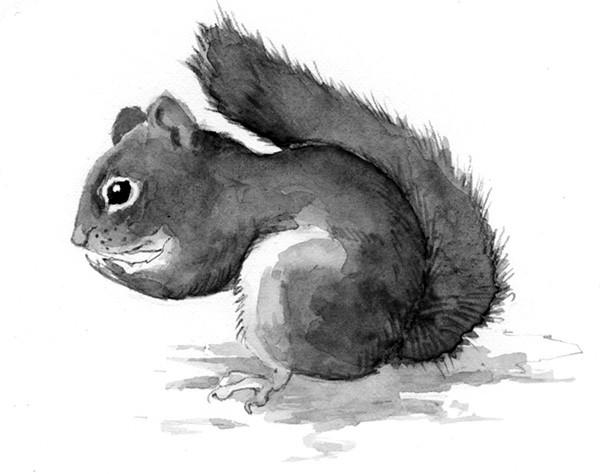
In the woods behind our house, there’s a pile of cones and gnawed apart bracts – easily two feet deep and twice as wide – built against the trunk of a tall hemlock. We’ve watched over consecutive winters – when the newly discarded bracts stand out against the snowy white backdrop – as the heap continues to expand.
This pile, called a midden, is the work of a single red squirrel. Red squirrels are active year round and generally easy to spot – and even easier to hear as they scold passersby in their high, chattering voice. There are several red squirrels in the wooded area near our home. In autumn, we see them bouncing across the fields carrying full evergreen cones in their mouths and, this time of year, we find their bounding tracks in the snow. Also known as pine squirrels or chickarees, these tiny-but-bold redheads measure about eight inches long, not including tails nearly as long as their bodies. They’re solitary (except during a brief mating period in spring) and aggressively territorial. To paraphrase Shakespeare, though they be but little, red squirrels can be fierce!
Red squirrels have a varied diet, noshing on anything from nuts to fungi, fruits and sap, and sometimes even bird eggs, young birds and newborn snowshoe hares. This time of year, however, their most common food is the seeds extracted from the cones of hemlock, fir, spruce, and pine trees. They store their seeds in middens, which serve as both refuse piles for past meals, and cold storage for future ones.
Middens tend to be centrally located in a squirrel’s territory, which may span up to four acres. Over the course of the fall, red squirrels will ascend conifers and cut green cones from the treetops. After dropping numerous cones to the ground, a squirrel descends the tree to collect and carry them off to one of several storage areas, including its main midden. One squirrel may collect more than 15,000 cones during this fall activity.
It’s imperative that squirrels do their annual food gathering before the cones open and allow the seeds to scatter. “The middens provide a great storage place for the green cones, with the cool and moist conditions necessary to keep the cones from drying out and opening,” says Margaret Gillespie, a naturalist at Squam Lakes Natural Science Center in Holderness, New Hampshire. “They pack the cones in tightly, and in a large midden there is probably enough food stored for next winter as well.”
So why all the discarded cone bracts in our backyard midden? Often, after collecting a cone from their pile, a squirrel will ascend to the safety of a nearby favorite perch, and drop the inedible parts of the cone back into the pile.
With all the work that goes into hoarding their food, it’s no wonder red squirrels are so vocal about their territory. And a little paranoia is warranted: red squirrels will steal from each other. In the red squirrel’s western range, grizzly bears are known to raid middens in whitebark pine stands for a free meal. It seems our eastern black bears may be more polite.
“Black bears in New Hampshire are dormant for most of the winter. And in the spring, they tend to eat grass and new vegetation,” says Gillespie. “If they came across a squirrel midden, they certainly could smell the cones and any nuts stored there, but it’s probably not a big factor.”
You’re probably not likely to raid a red squirrel’s seed hoard, either. But if you get too close, you may hear a little chickaree scolding you with a big voice. If you’re in the woods this winter, you’re sure to find the distinctly four-footed tracks of these small mammals laced across the snowy landscape. Look closely, and you may find a midden as well.


Discussion *